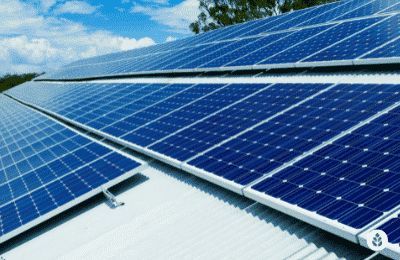
Oklahoma Solar Incentives (Rebates, Tax Credits & More in 2024)
In this guide to reducing the cost of solar panels using incentives in Oklahoma, you’ll learn:
- What solar incentives are available in Oklahoma?
- How much can you save with solar benefit programs in Oklahoma?
- How do you file for the federal tax credit in Oklahoma to make sure you get the full amount?
Each product and or company featured here has been independently selected by the writer. You can learn more about our review methodology here. If you make a purchase using the links included, we may earn commission.
Do Oklahoma Solar Incentives Make It Affordable for Homeowners to Go Solar?
Yes, incentives and other benefits can make going solar in Oklahoma affordable and readily accessible in most cases. However, prices for installing solar systems in Oklahoma can be higher than the national average.
The average price of a photovoltaic (PV) system in Oklahoma is $36,740, which is about $7,000 higher than the national average. This is largely due to the above-average energy needs for Oklahomans. The cost per watt to install a solar system in Oklahoma is slightly below the national average, but Oklahomans typically need a larger-than-normal system, that doesn’t mean that going solar is not worth it in Oklahoma. In fact going solar in Oklahoma can still save buyers more money in the long run.
These costs can be reduced by a variety of federal and local incentive programs designed to encourage people to install solar power.

Shine Solar, LLC

Regional Service
Average cost
Pros
- Many financing options
- Great warranty coverage
- Offers a panel buy-back option
- Outstanding workmanship
Cons
- Relatively young company
- Limited brands of solar equipment available

Astrawatt Solar

Average cost
Pros
- Comprehensive service offerings
- Excellent reputation
- Award-winning company
- Educational, no-pressure sales approach
Cons
- Limited service area
- Relatively young company
Below is a breakdown of all of the solar incentive perks available in your area. We include the average savings that each provides, wherever possible.
| Solar Incentives in Oklahoma | Incentive Type | Description | Occurrence | Estimated Dollar Amount You Can Receive |
| Federal Solar Investment Tax Credit (ITC) | Federal | Credits your income tax liability with 30% of your entire solar power system cost, including panels, solar batteries and inverters. | One-time: The credit is determined once when you file your taxes for the year you go solar. The credit can apply for up to five years. | $11,022, on average |
| Net Metering | Local | Credits your future energy bills based on how much excess energy you generate and send to the grid. | Always in Effect: You will continuously earn energy bill credits for as long as your panels generate power. | Varies based on your solar power system size and your monthly energy bills |
| Local Incentives | Local | Additional perks offered by local utility companies, cities and other organizations. | Varies based on the specific perk. | Varies based on the incentive, your PV system size, and your conversion costs |
What Do Oklahomans Need to Know About the Federal Solar Tax Credit?

The tax credit dates back to 2005 and was originally set to phase out beginning in 2021. It would then no longer be available starting in 2024.
This changed in August 2022 when Congress passed the Inflation Reduction Act (IRA). This piece of legislation pushed the expiration date forward by 10 years and increased the credit rate for 2022 back up to 30%, including solar panel installations that took place earlier in the year before the bill was signed.
The new planned rate decreases are as follows:
- 30% for installations completed between 2022 and 2032
- 26% for installations completed in 2033
- 22% for installations completed in 2034
- The credit will expire in 2035 and will no longer be available thereafter
How to Claim the Federal ITC in Oklahoma
Claiming the federal credit is straightforward, and you’ll only have to fill out a single form to get access to the $8,500+ tax credit. You can follow the steps below to ensure you get access to this perk.
- Step 1: After your system is installed and commissioned, print out IRS form 5695. This is the form for claiming residential energy credits for clean energy systems.
- Step 2: Fill out the form with information about your solar power system, including the size and cost. You’ll also need information about the company that handled the installation process.
- Step 3: File the form when you file your taxes or provide the form to your accountant at the end of the year.
We should mention that you can usually skip these steps if you use tax software to file, like TurboTax. These programs prompt you for information about renewable energy installations, so you can provide the required information directly instead of using the printable form.
EcoWatch’s Opinion on the Federal ITC in Oklahoma
The federal solar tax credit is by far the most valuable perk when installing a new system – and well worth your time. The application process is easy and fairly quick, but the potential value you’ll see from the incentive is outstanding at over $11,000, on average.
This credit is a crucial part of saving money on solar panels no matter where you live. It’s particularly helpful in places like Oklahoma, where other solar incentives are lacking.
However, it’s important to remember that this perk is not a solar rebate, and you’re not guaranteed to get access to the full amount. The amount you can take as a credit is limited by what you owe on your income taxes. If you owe nothing or the government owes you, you can’t take any of the credit.
Thankfully, you don’t have to take the full credit all at once, and you can roll over unused credit for up to five years total (including the first year). That means you can still take the whole credit amount if you owe at least $2,204 on your taxes each year following the installation.
Watch Below: Is Solar Actually Worth it In Oklahoma?
Net Metering in Oklahoma
Net metering — also called net energy metering or simply NEM — is a billing policy that helps solar customers realize the maximum value their panels can provide. Through interconnection, this perk monitors the excess power your system generates and sends to the grid. It then credits you for each kilowatt-hour (kWh) you send.
The more power your panels generate, the more you can potentially save on future electricity bills.
The Oklahoma Corporation Commission (OCC) — the governing body for energy costs and net energy metering in the state — mandates net energy metering for all investor-owned utilities (IOUs). These include:
- Liberty Utilities (used to be Empire District Electric Company),
- Public Service Company of Oklahoma and
- Oklahoma Gas & Electric (OG&E)
However, the amount of credit you receive for energy you produce is set at the avoided cost rate, which is below the retail value you’d pay for incoming electricity. This is less than ideal, although any NEM policy will help you save money over time.
You can also be charged a fee for enrolling in the program. It’s possible that the program in your area will disappear in the future, although there is no evidence to suggest that it will any time soon.
How to Enroll in Net Energy Metering in Oklahoma
Enrolling in net energy metering is typically a quick and painless process, and most solar customers in the state won’t have to do anything themselves to take part. The majority of reputable solar installers in the state will tackle the interconnection application process for you, so enrollment is more or less automatic for most homeowners.
We still recommend you follow the steps below to ensure you get access to this perk, as it can save you a large amount of money on your energy bills.
- Step 1: Call your utility company to make sure you’re eligible for NEM. Investor-owned utilities are required to offer the program, but electric cooperatives and municipal utilities can opt to offer it as well. You’ll also want to make sure that you have a bidirectional meter installed. Most homes have already been upgraded to include one, but you can get one installed for free if you don’t have one already.
- Step 2: Choose a solar installer in your area and make sure that it will handle the NEM application. Most reliable companies will do this for you, but you’ll have to confirm you want to be enrolled, given the charge involved.
- Step 3: Complete your home solar project.
- Step 4: Check your energy bills for a month or two after the installation process to make sure that you’re accruing credits. If you aren’t, contact your installer to assess what the issue is.
EcoWatch’s Opinion on Net Energy Metering in Oklahoma
Net energy metering is an outstanding perk, although Oklahoma’s local policy leaves a lot to be desired. The OCC essentially offers the worst-case scenario when it comes to NEM—the avoided cost rate for exported electricity—although having a policy is always better than not having access to the program at all.
The biggest issue we have with net energy metering in Oklahoma is that electric companies can impose a charge for enrollment. We’d also prefer that utility companies offer credits based on the full retail price of the energy.
That said, taking part in NEM will still very likely save you money on your electric bills over time. According to the Solar Energy Industries Association (SEIA), this program is one of the most valuable perks available for solar customers in the country.1
Thankfully, the process of enrolling is straightforward and shouldn’t take any time or effort at all in most cases. Your installation company will usually handle the process for you.
Local Solar Incentives in Oklahoma

However, there are local perks for other energy efficiency upgrades that you can couple with your solar installation. We’ll include a list of these benefits below.
- Edmond Electric Efficiency Incentives: Customers of Edmond Electric can receive rebates for installing things like geothermal heat pumps, general heat pumps, insulation and other efficiency upgrades.
- Oklahoma Electric Cooperative (OEC) Efficiency Incentives: There are cash-back incentives available for OEC customers who install things like heat pumps, geothermal equipment and electric water heaters.
- OG&E Efficiency Incentives: OG&E has a slew of cash-back perks for things like AC tune-ups, efficient windows, insulation services and LED lighting.
- Oklahoma Municipal Power Authority (OMPA) Ways I Save Electricity (WISE) Rebate Program: OMPA customers can take cash-back incentives for heat pumps, geothermal equipment installations, insulation, new HVAC equipment and other energy-efficient equipment.
- Public Service Company of Oklahoma (PSO): PSO has a handful of cash-back rebate opportunities for new appliances, insulation services and HVAC equipment.
- Verdigris Valley Electric Cooperative: This energy provider includes rebates for things like heat pumps, LED lighting, smart thermostats and other energy-saving devices.
Contact your electric company to see if it offers additional incentives, or you can check on the Database of State Incentives for Renewables and Efficiency for more information. There also might be perks you can take that are offered by the U.S. Department of Energy.
Which Tax Incentives Are The Best In Oklahoma?
Oklahoma isn’t the most generous state when it comes to solar incentives, but the two that are available to Oklahoma residents can save you a huge amount of money.
First, we suggest you make sure you take the federal credit. This provides the biggest value for most customers, as long as they owe money on their income taxes for one to five years after the installation. It takes just a few minutes to apply for, and it provides an average potential savings of over $11,000.
Second, we recommend applying for net energy metering if it’s available from your electric company. Even if there’s a charge imposed for taking part in the net metering program, we think it’s well worth the investment.
Not only does NEM boost your long-term energy savings, but it also helps pay off your panels more quickly and adds more value to your home. It’s especially helpful because of the above-average energy consumption in the state. NEM can help offset the electricity you need to purchase, even during times of minimal production — like on cloudy days or at night.2
Both of these incentives would be helpful anywhere, but they’re especially important to take advantage of since there are no other perks available in the Sooner State.
What’s The Near-Term Outlook For More Incentives In Oklahoma?
As of right now, there is nothing to suggest that there will be any major changes to the solar perks available in the near future.
If there is a change, we’d expect it to be to the net energy metering policy. This program has gone through several changes in the past, and it’s generally the perk that gets changed first in other states. As more customers convert to solar in the area, it’s possible that the enrollment charges will increase or that the opportunity for interconnection will disappear altogether.
The cost information presented in this article is derived from a comprehensive analysis, incorporating data from multiple industry sources. The average cost per watt per state was calculated based on figures from Consumer Affairs, Energy Sage, and Berkeley Lab’s Electricity Markets & Policy Department. Additionally, monthly energy consumption and the average monthly cost of electricity were sourced from the U.S. Energy Information Administration, ensuring a well-rounded and accurate representation of the information presented.
Oklahoma solar incentives FAQ
At EcoWatch, we’re happy to get questions about the process and costs of getting rooftop solar from Oklahoma residents. Below are some of the questions we see most often, along with our responses. If you have specific questions that aren’t answered here, reach out to our team of solar experts at solar@ecowatch.com.
At the time of writing, there is no plan in place for new incentives to be offered in the next two years.
As mentioned above, the state’s RPS goal expired in 2015. Since this goal is often what incentivizes utility providers and municipalities to offer additional perks, we don’t expect to see new opportunities in the area unless a new goal is set.
The Inflation Reduction Act (IRA) changed two things related to energy efficiency: the federal credit for solar equipment and the credits available for electric vehicles (EVs).
The IRA extended the federal tax credit program by more than 10 years, pushing the expiration date from 2024 to 2035. It also increased the credit rate for installations done in 2022 — retroactively and for the remainder of the year — from 26% to 30%.
The new EV tax credits max out at $7,500, which is higher than they were prior to the IRA being passed. There are new rules about which cars can qualify for the credits as well, which are designed to promote EVs manufactured in the U.S.
No, Solar Renewable Energy Certificates or SRECs are not available to Oklahoma residents. These certificates are earned for all solar energy production in areas where there is an open and active SREC market.
Regardless of how you use the energy, you earn one SREC for every 1,000 kWh your panels generate with renewable energy sources, like solar systems. The credits can be sold for a profit to energy companies that need to buy down their fossil fuel consumption.
There is no active SREC market in Oklahoma, so local solar customers will not be able to accrue credits or get compensated for them.
There is no plan in place for the currently available incentives to go away or become less valuable in the next two years.
It’s always possible that things will change, and if there is a downturn in the local incentives, we’d expect NEM to take the first hit. We could see higher rates charged for enrollment or the program going away entirely.
Since the RPS goal expired nearly a decade ago, though, we don’t foresee this happening in the next two years.
Unfortunately, no, the state doesn’t have exemptions on property taxes or sales tax when it comes to PV systems. That means your property taxes will likely increase as a result of solar conversion, and you’ll have to pay sales tax on your entire solar energy system.
Top Solar Installers in Oklahoma Cities
Comparing authorized solar partners
-
- Many financing options
- Great warranty coverage
- Offers a panel buy-back option
- Outstanding workmanship
- Relatively young company
- Limited brands of solar equipment available
A-Outstanding Regional Installer
Having trouble deciding? Click below and use our process to receive multiple quotes instead:

 233k
233k  41k
41k  Subscribe
Subscribe 


